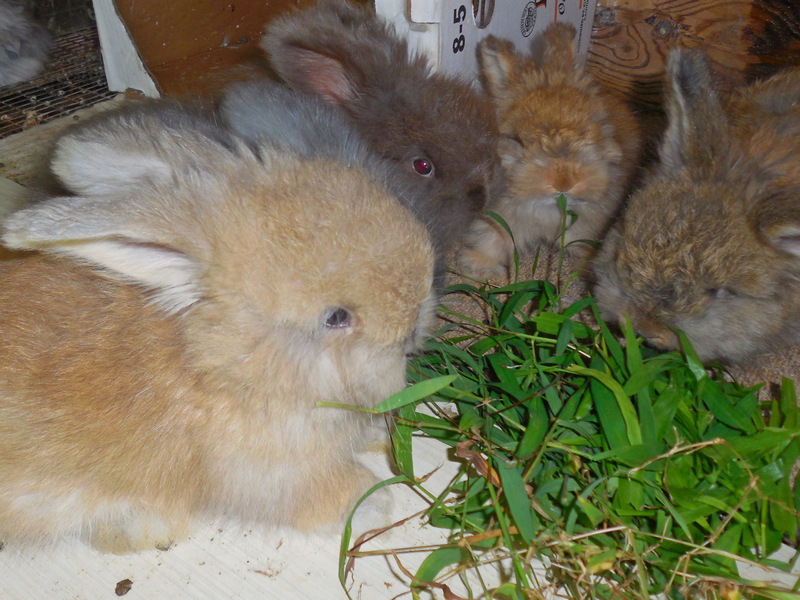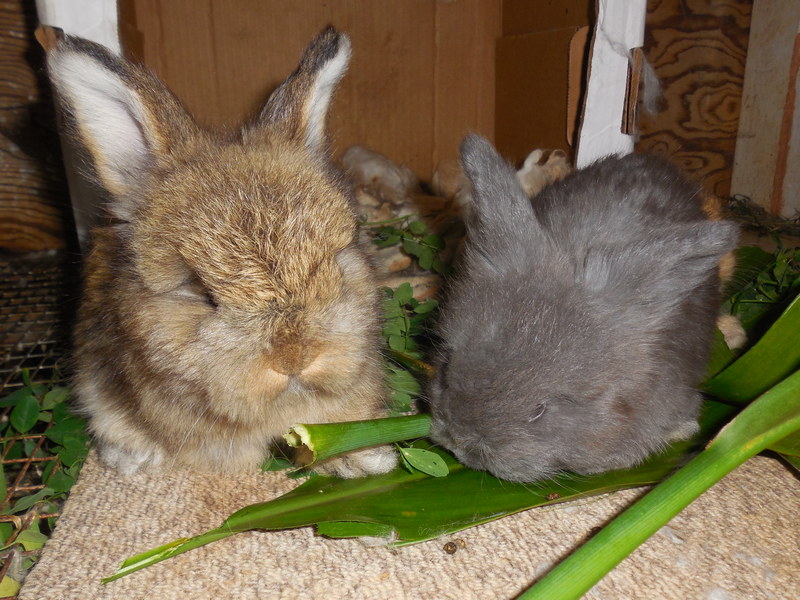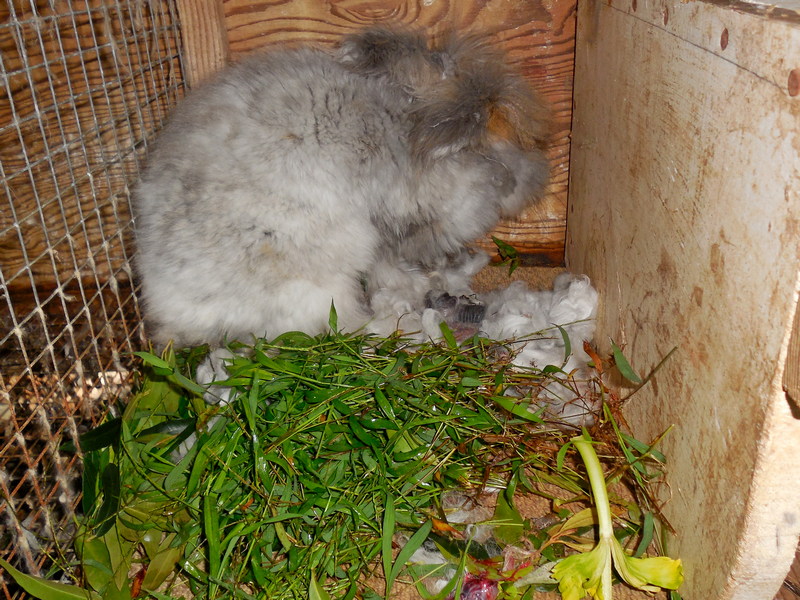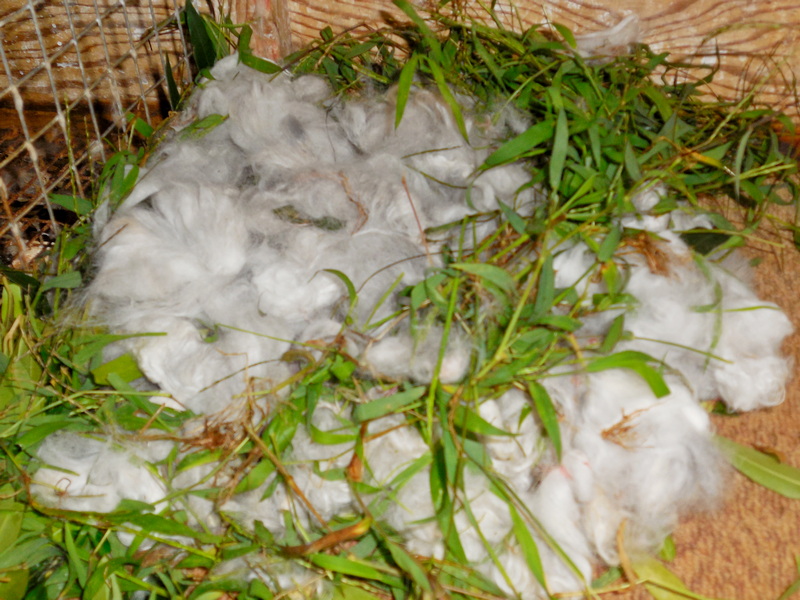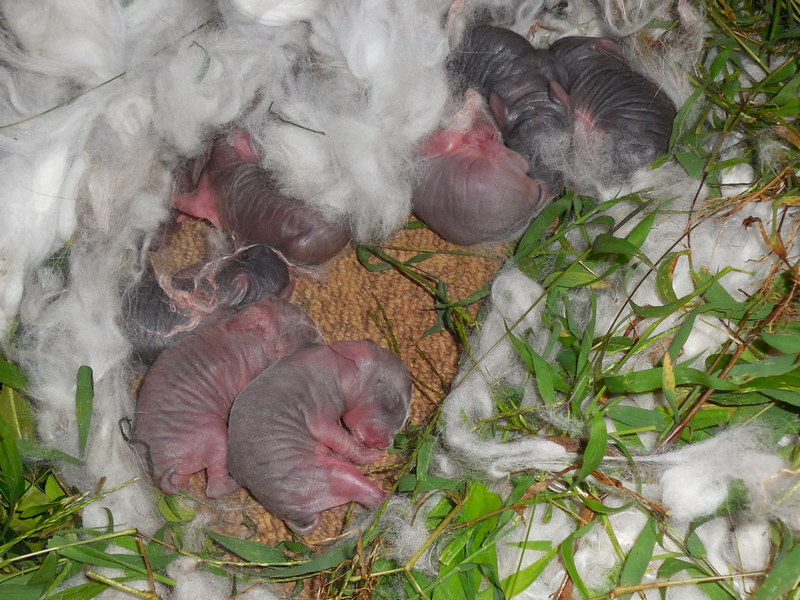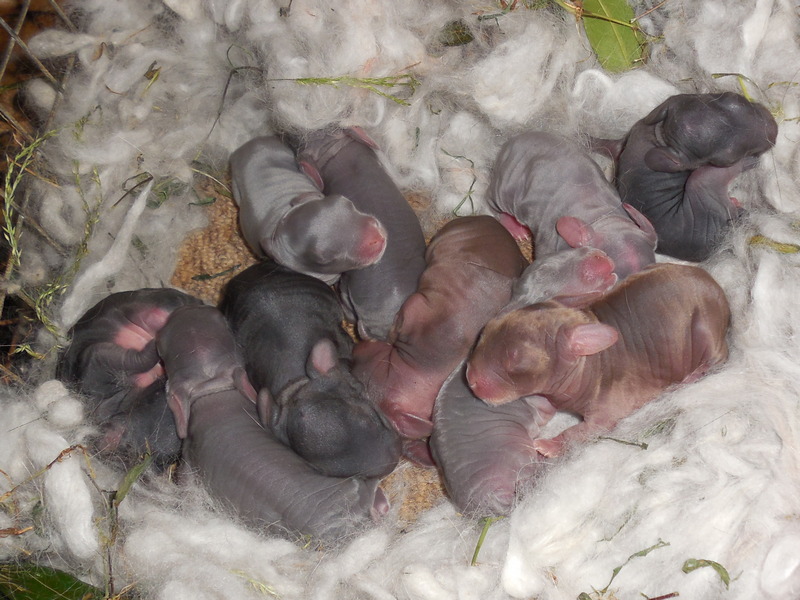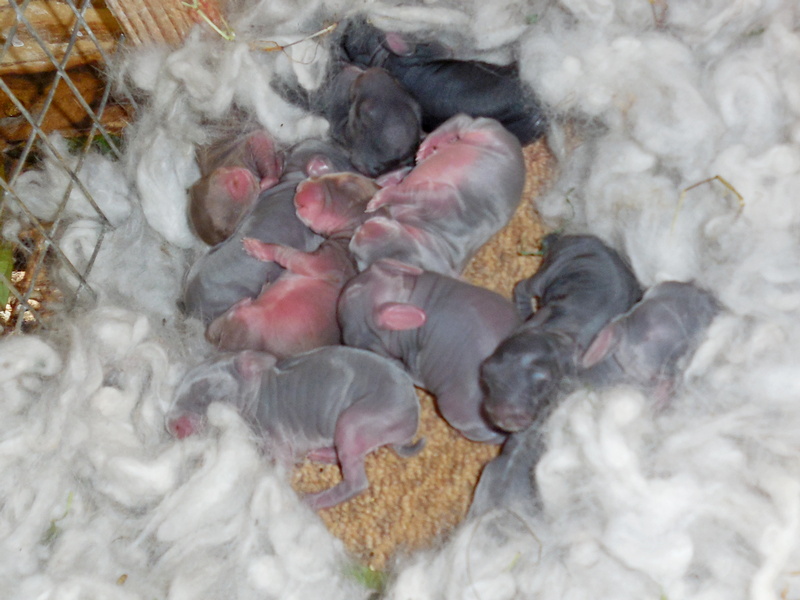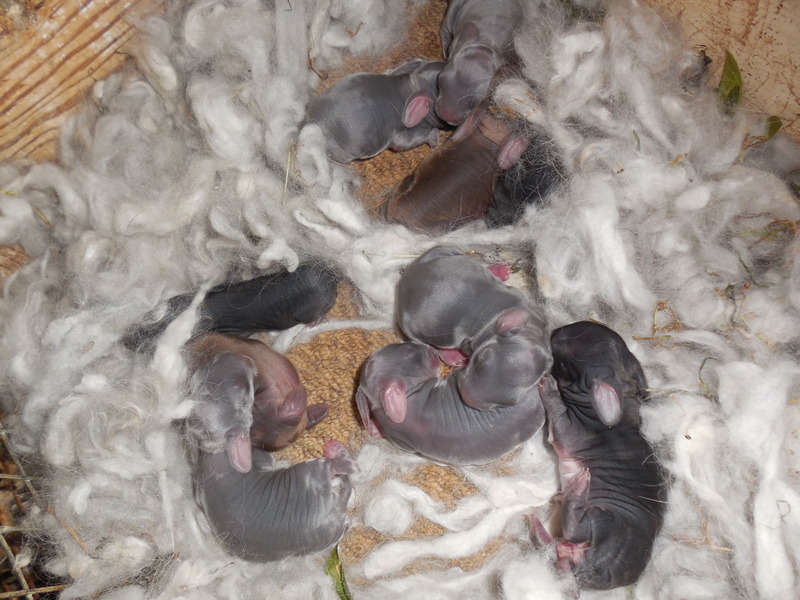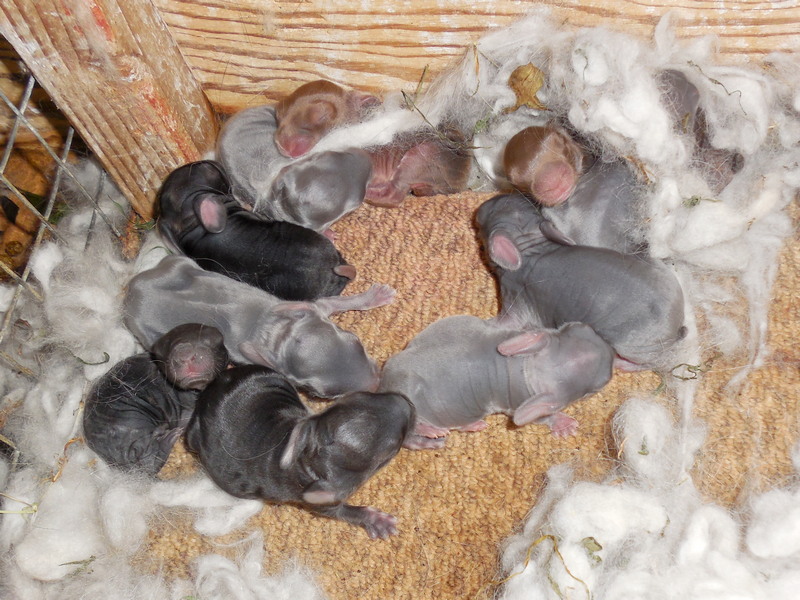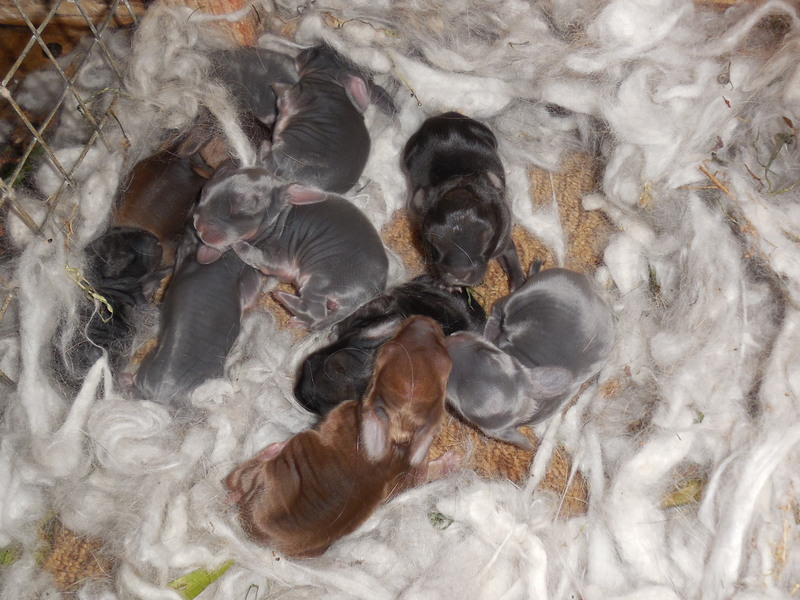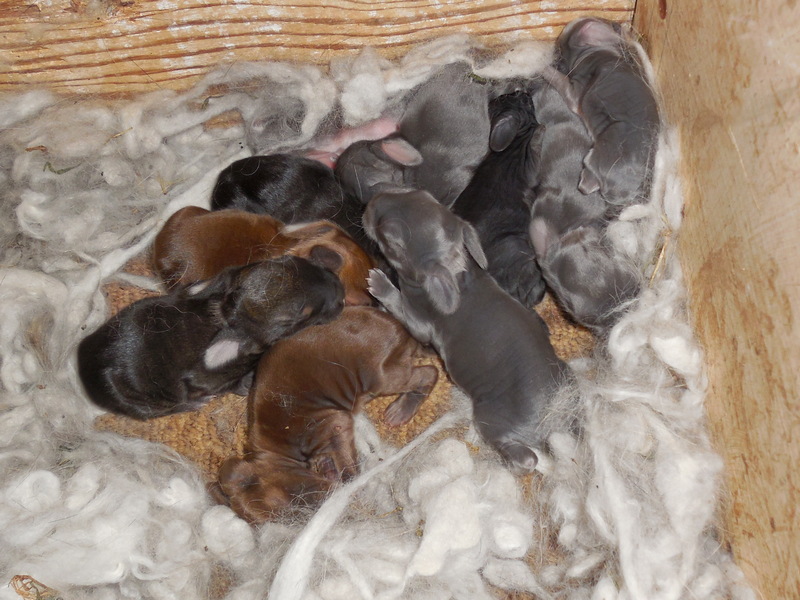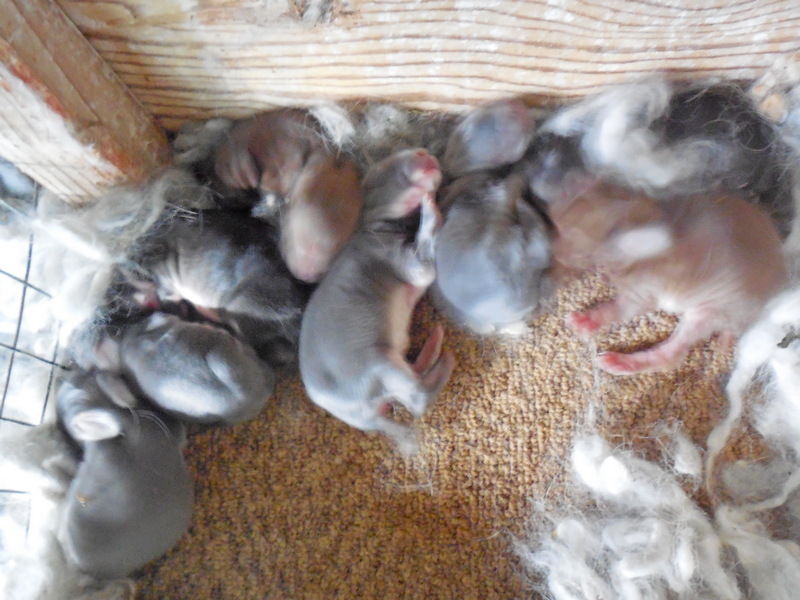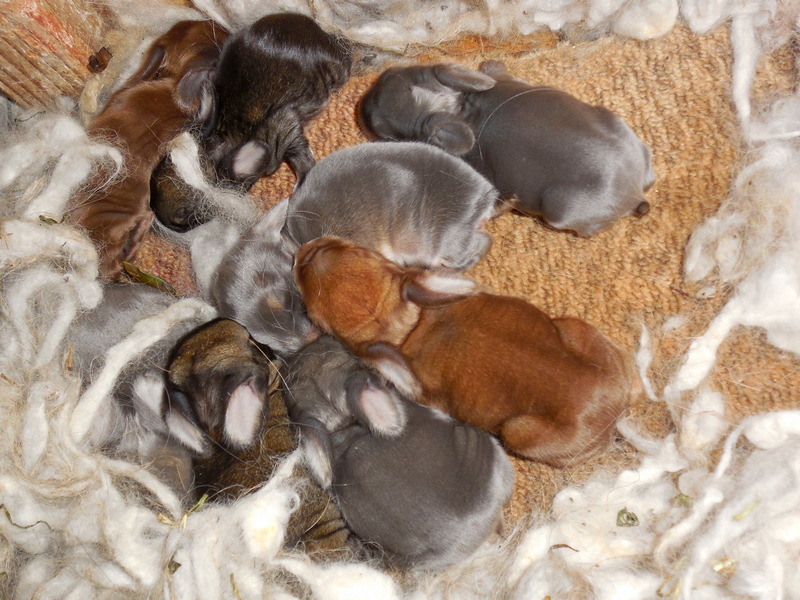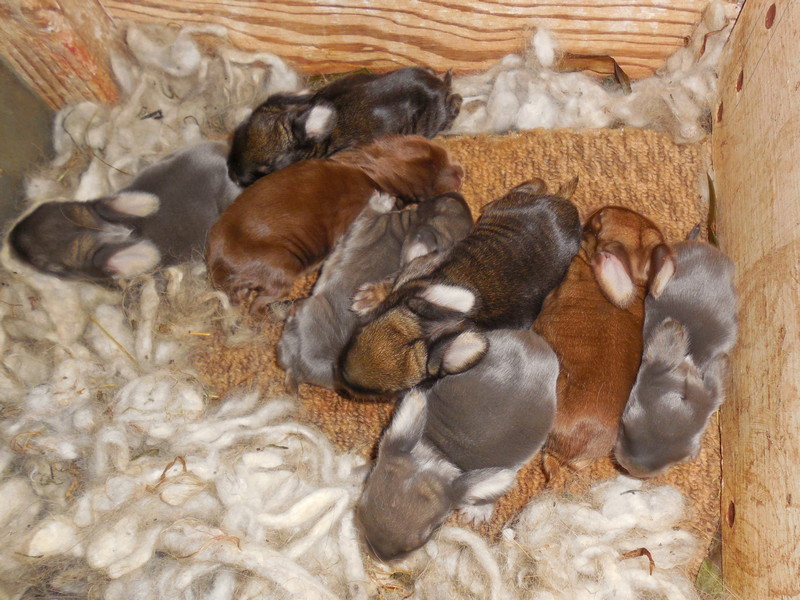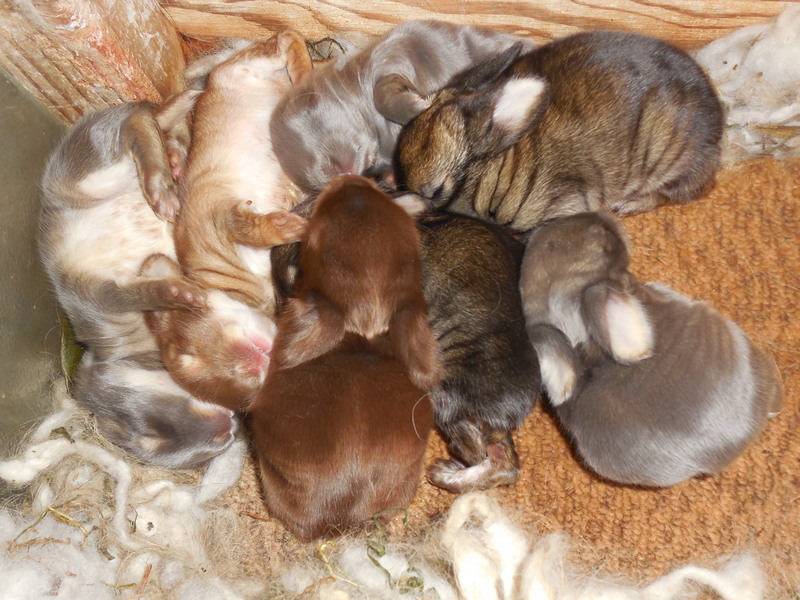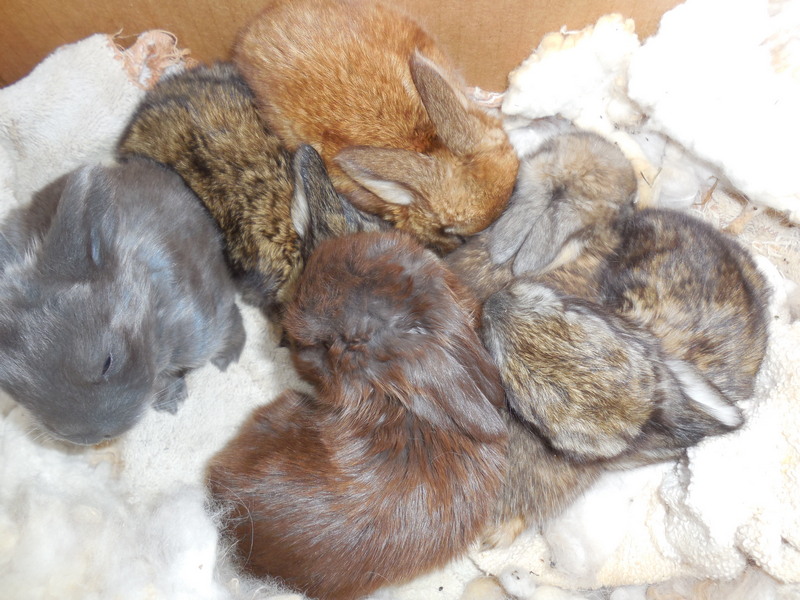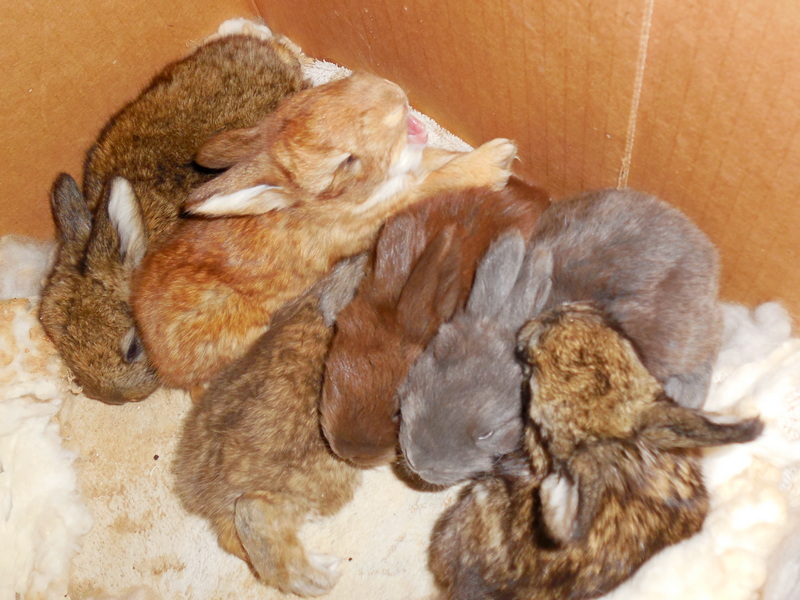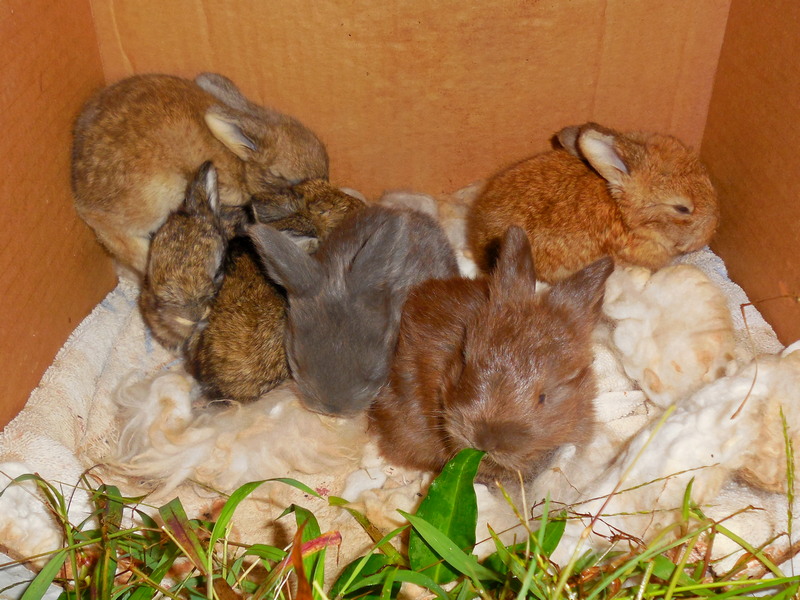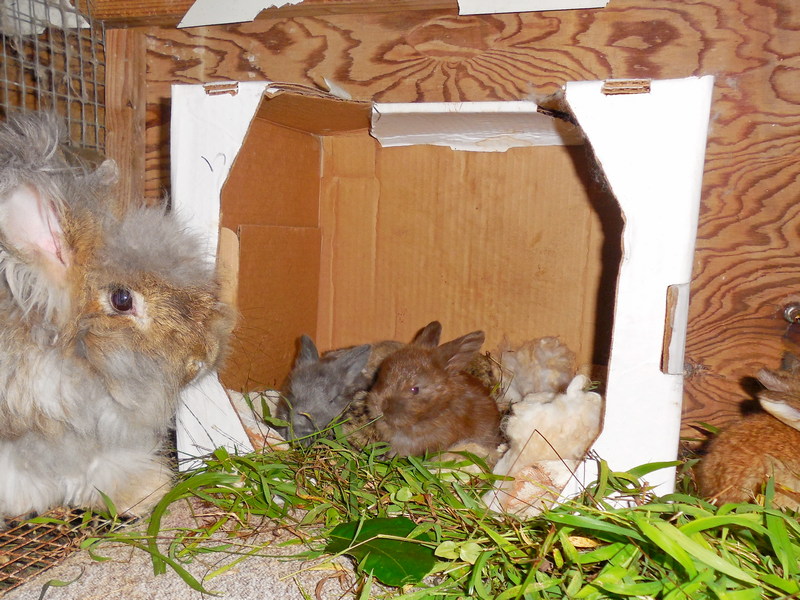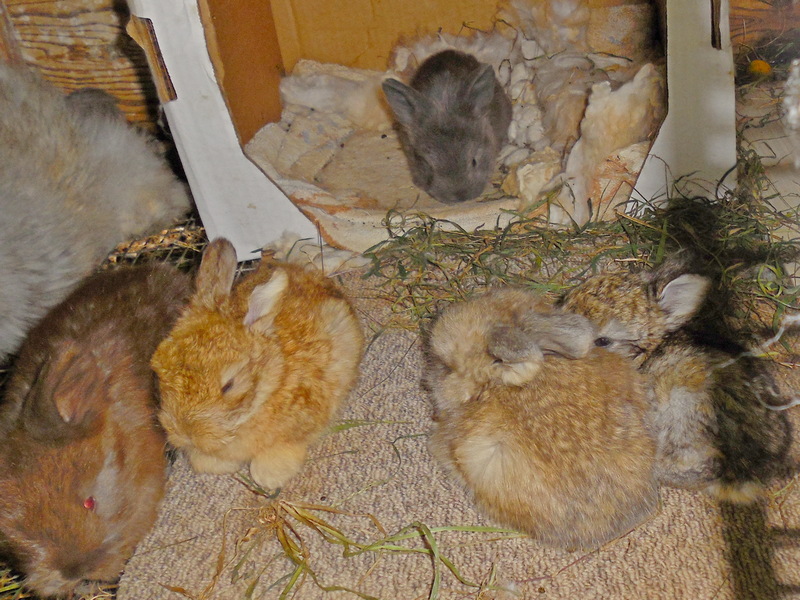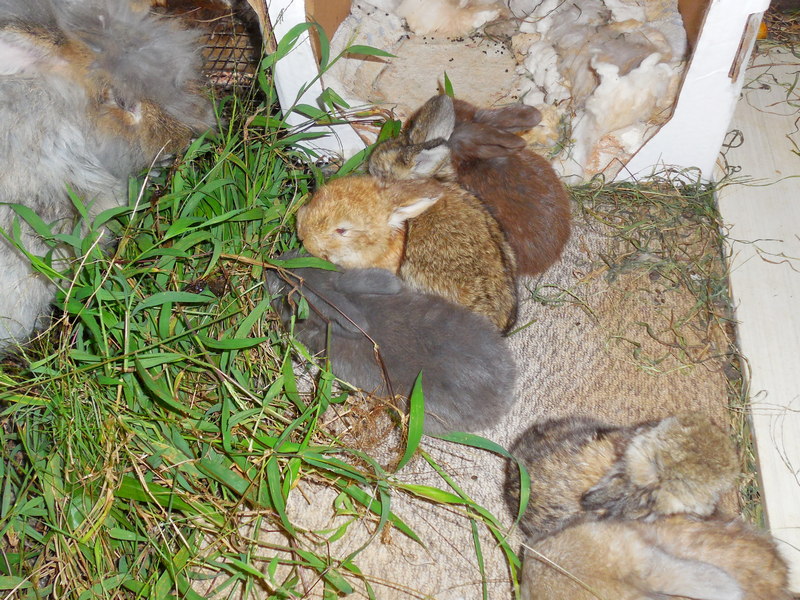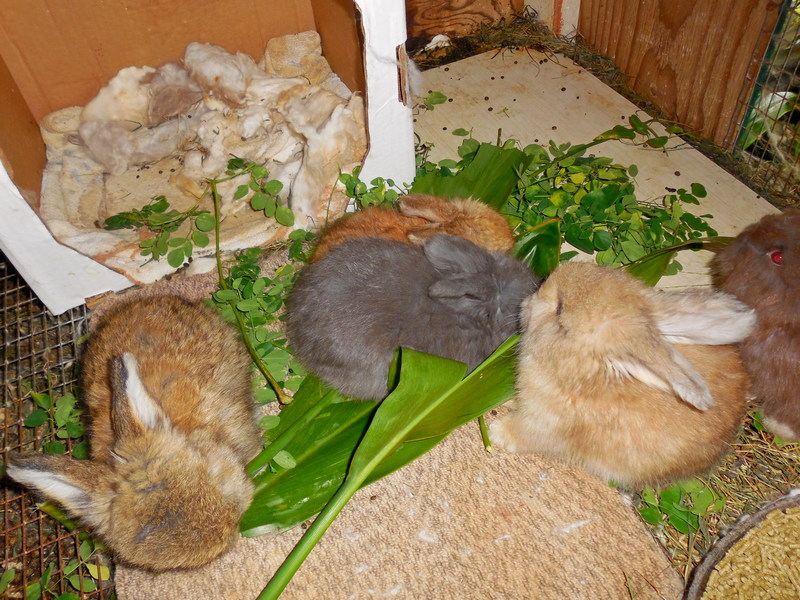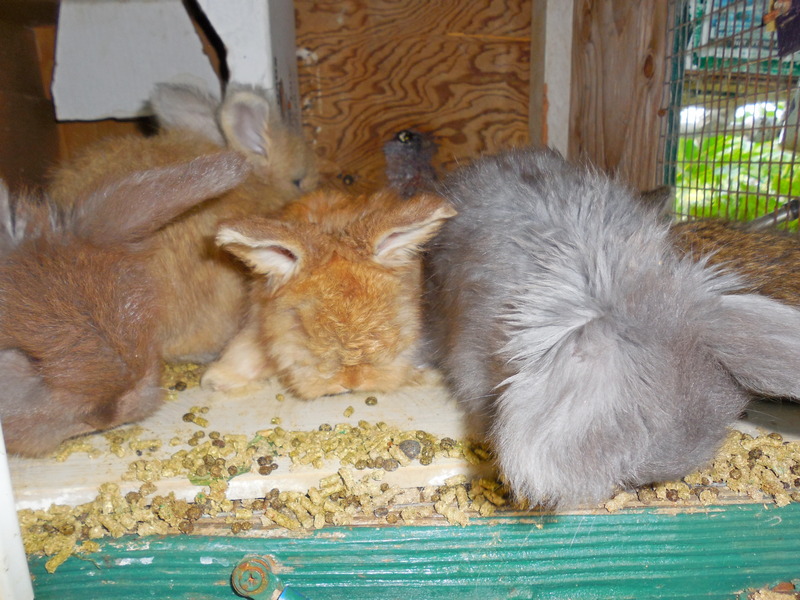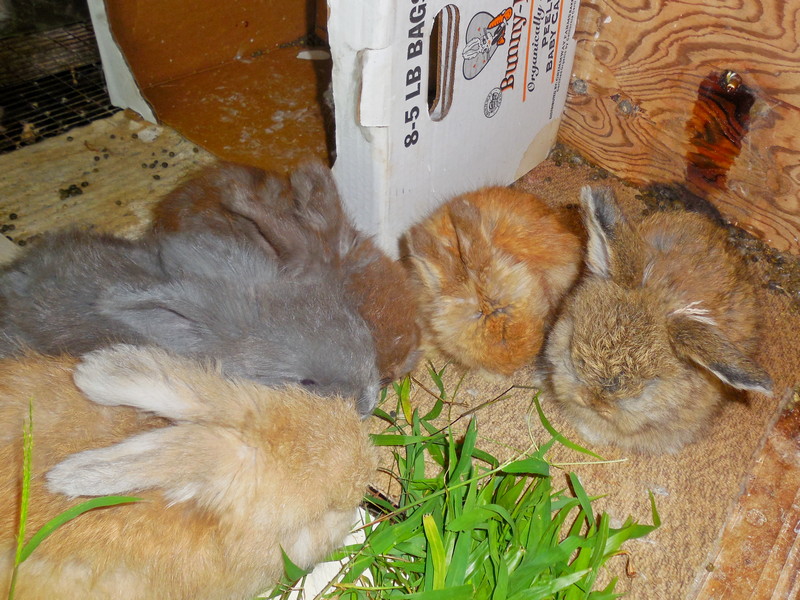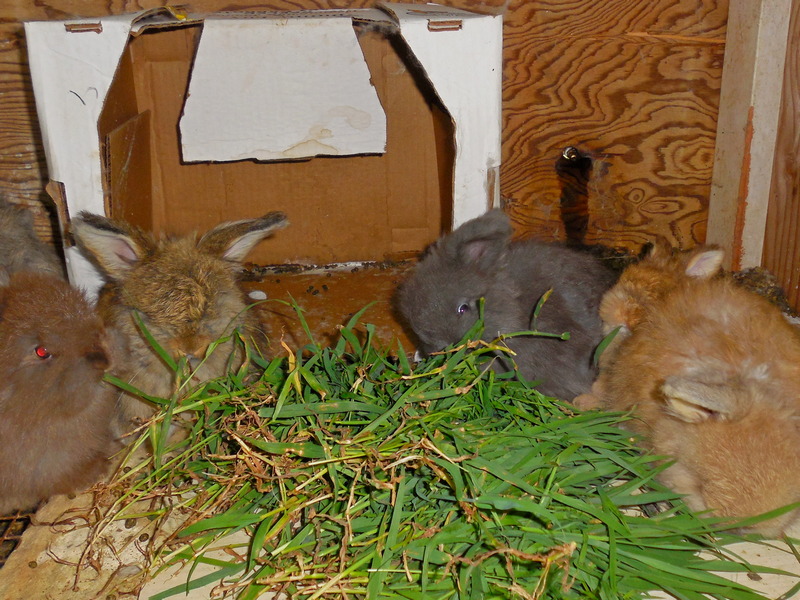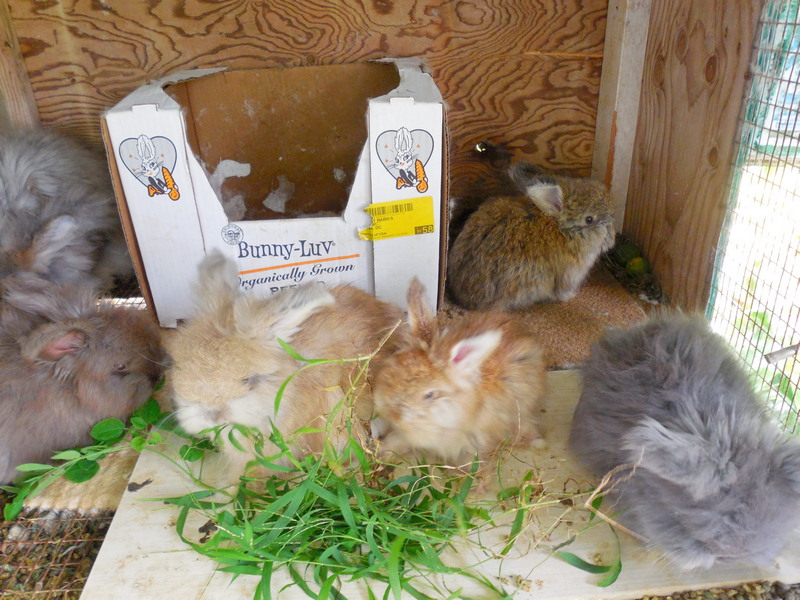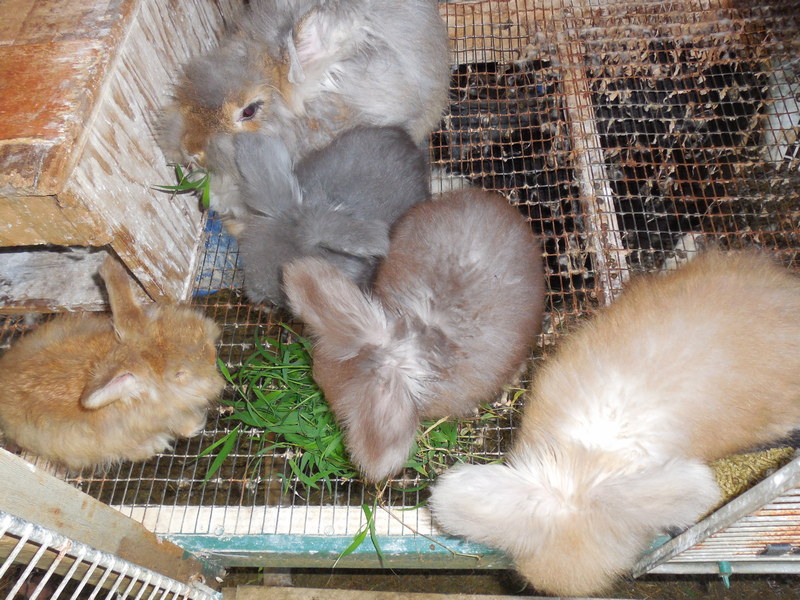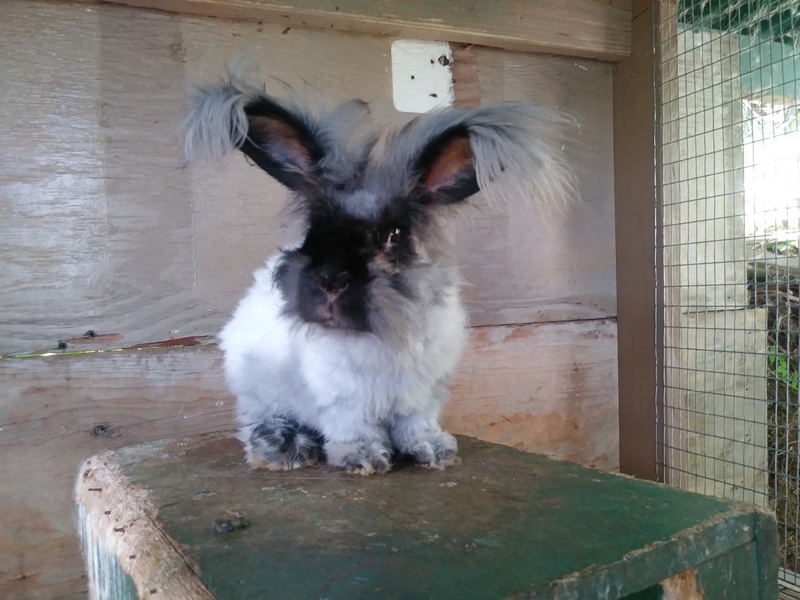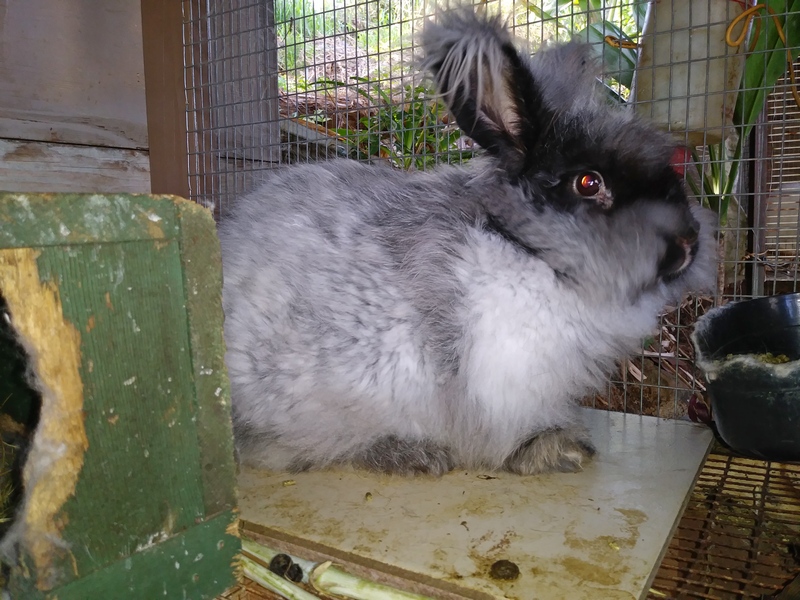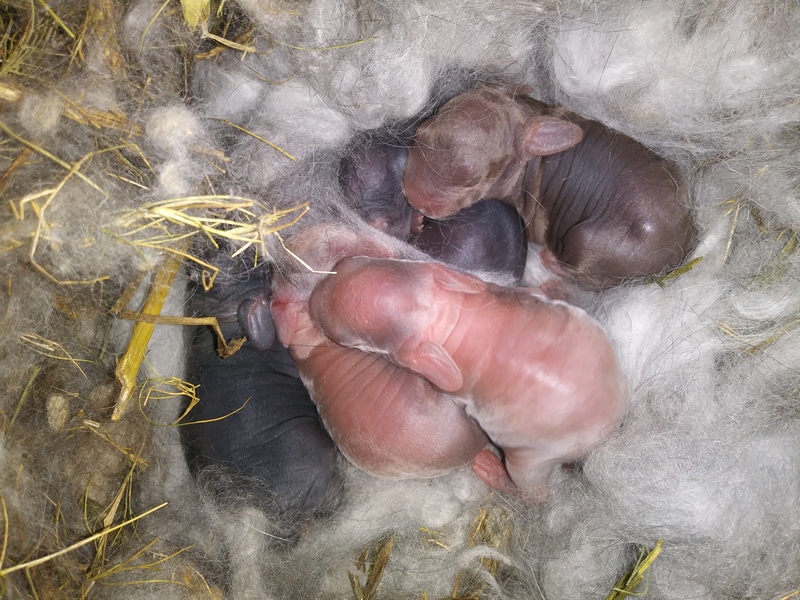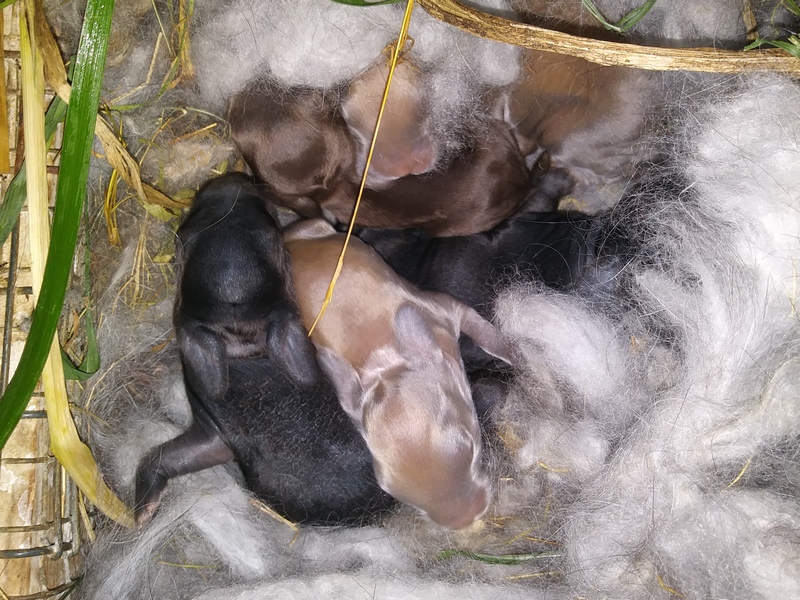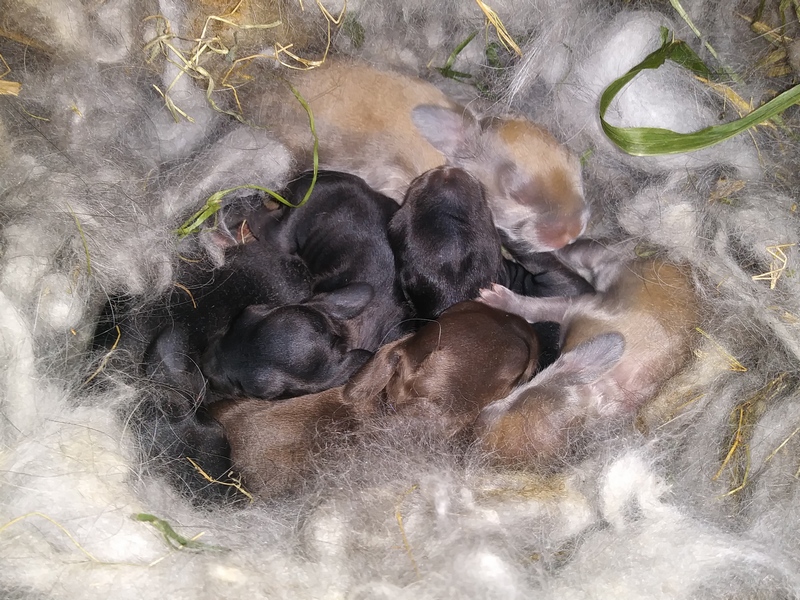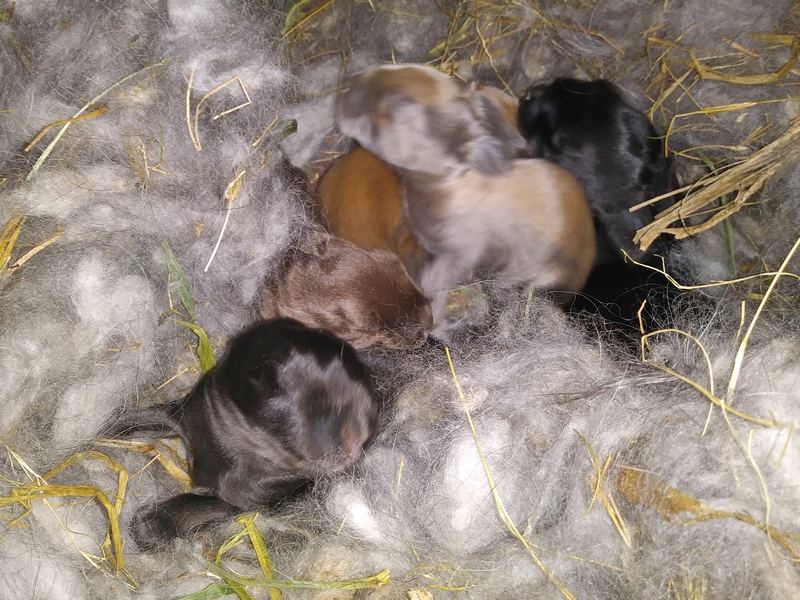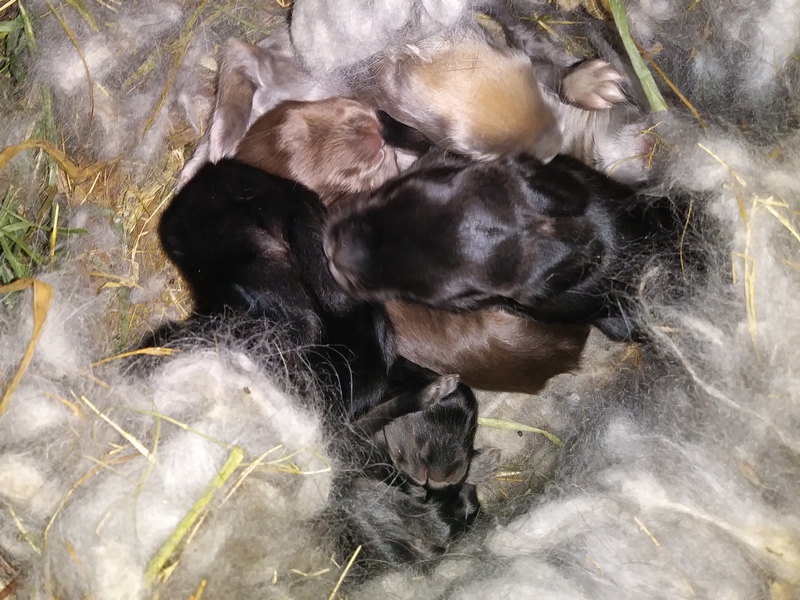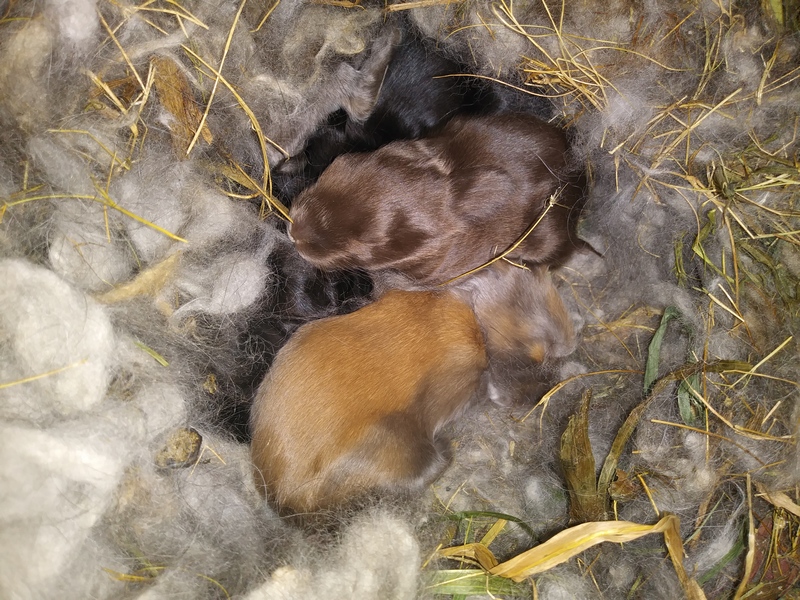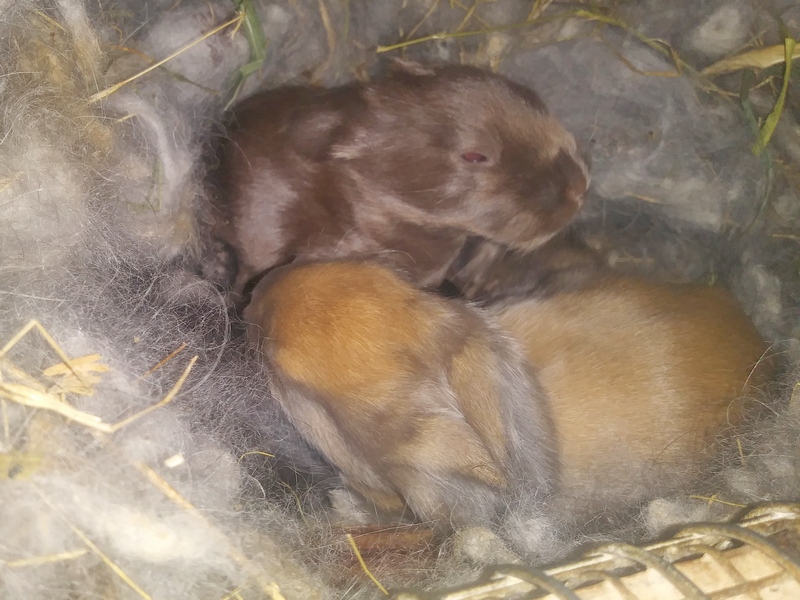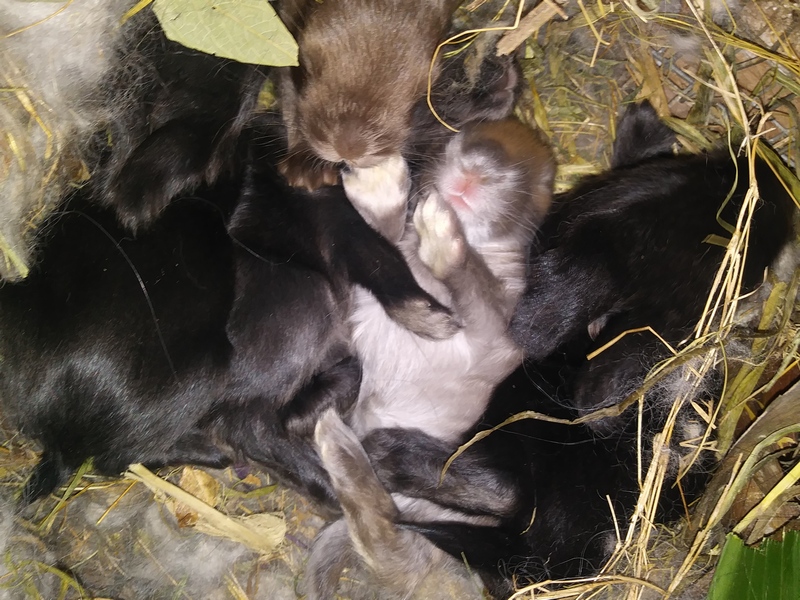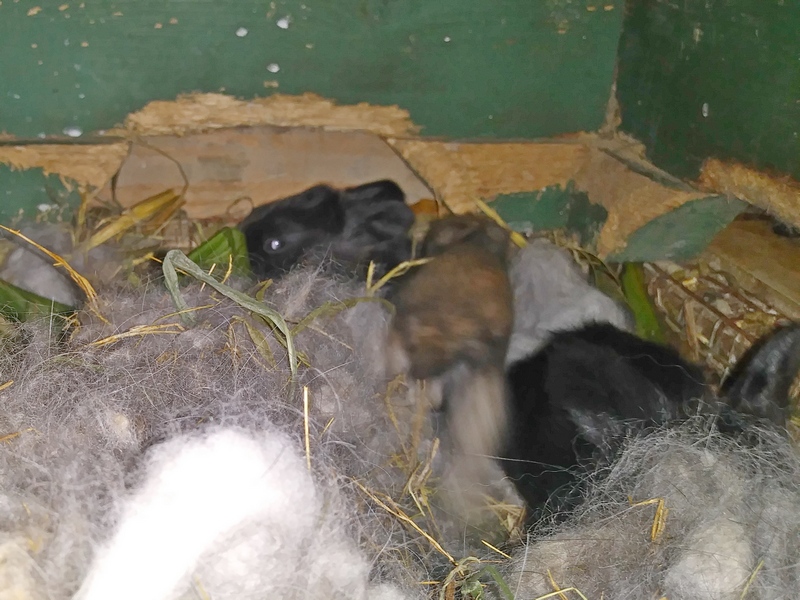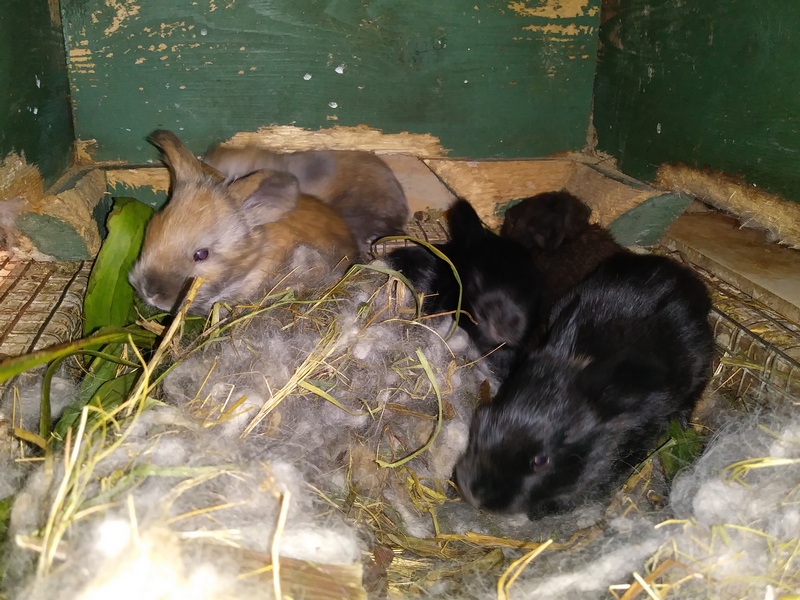Baby Angora Bunnies
😊
Watch them grow up Day by Day
also known as "the path to cuteness overload"
Baby bunnies don't really start out all that cute, but they get that way pretty quickly. Here's a day by day pictorial of a litter of English angora baby bunnies growing up here at Hillside Farm in Hawaii. Clicking on their picture should bring up a bigger picture to see.
This is a litter between Hillside Toffee, the mum bun, and Hillside Twinkle, the dad bun. The babies were born in 2014, but they were one of the only litters where I'd been fairly consistent about taking their picture every day. Perhaps, later this year (2020) if we have any litters of baby bunnies, I'll try a daily picture again.
These pictures are pretty much from being born to about a month and a quarter old. At that time, we'd gotten busy with another house we'd bought so there wasn't as much time for taking pictures of baby bunnies.
Building the Nest
😊
If everything is going the way it usually should, several days before the babies are born, the doe will start to build a nest. Baby bunnies are born very small and hairless with their eyes shut, so they need a safe warm place for at least the first ten days although it's even better if they have the nest for the first month. Even at a month old, they aren't really going to outrun many predators, so bunny babies need a safe and secure nest.
The doe will find what she considers to be a safe spot, one hopes it's inside the nest box that is provided to each nesting spot in the big bunny hutch, although the bunnies don't always go along with our plans. Once she finds the spot, she will gather up grasses and other nesting materials and take it to the nest. That's known as a 'grass moustache' among folks in the bunny world.
Nest Building with a grass moustache
I didn't get any pictures of Toffee with a grass moustache, that's Cheiri in the pictures building a nest in 2017. If you see a bunny carrying grasses somewhere, most likely it's a doe building a nest. Bunnies don't seem to move their food around, they generally eat it where they find it. About the only time you'll see them with greenery in their mouth is when nest building.
The other things bunnies can't carry is baby bunnies. Cats and dogs can move their babies to a safe spot or carry them out of trouble, but bunnies aren't able to do the same thing. Which means the doe has to pick a good spot for her nest since she won't be able to move the babies when they're born. Even something as simple as moving them a few inches back into a warm nest.
We've constructed dropped nesting areas so if the babies do get out of the nest somehow, they can then roll back in again. Sometimes with a nesting box that has a raised lip to keep them in, the nesting materials will ramp up behind the lip and then the babies can fall out and not be able to get back in or be carried back in by the mom bun.
Nest building outside the nest box. Sigh!
This is Toffee building her nest. You may notice she's making her nest outside of the nest box. I'd put all the nesting materials in the nest box for her several times before and she persisted in moving it outside. Sigh! A bunny is gonna do what a bunny is gonna do. So, a piece of carpet was put under the area she selected for her nest. It's not the best compromise, but the carpet at least kept the grasses and fluff from falling through the wire.
A doe will pull wool from under her chin as well as her undersides to add to the nest. This not only provides a nice warm place for the babies, but it also allows more access to her nipples so the babies can drink easier. The doe doesn't stay with her babies, she will pop into the nest for a brief feeding several times a day and the rest of the time she stays away. Bunnies are a prey species, so she's staying away from the nest so there will be less likelyhood that it will be found by predators.
Ten Minutes and Two Hours old
The doe will have her babies pretty quickly, at least, the ones here do. Toffee barely had time to get the baby cleaned up a little before she had the next one to work on.
The first picture was taken on March 24th at 3:27pm, 2014 when the babies were being born. They are less than ten minutes old in the first picture. Since we handle the babies literally minutes from when they're born, the bunnies are very used to humans and the doe doesn't panic if we are around. If your bunnies haven't been around humans as much, then staying away from the nest when she's having her litter may be beneficial in keeping the doe calm. Some folks say an upset doe will kill or even eat her babies, we've never had that happen but I hear folks talking about it occasionally.
The second picture is the same day but at about an hour and twenty minutes later at 5:44 pm. I'd pulled away some of the wool and grasses to take their picture, but this nest is in Hawaii so even though it's March, it's still not all that cold so the babies are not in a tight pile.
Day One of Toffee's Babies.
This is a day later and with ten babies, it's a huge litter. I don't generally count them until they are a week to ten days old since baby bunnies are just so delicate that almost anything can happen to them at this stage. As far as I can figure, just about anything wants to snack on baby bunnies. We've had rats get past the rat proofing, we've even lost some to ants of all things. They get out of the nest and they chill, they get to the other side of the nest box and.... Well, the list of things that can go wrong is huge. We try to make it as safe as possible, but we also don't count them for the first ten days so we won't be depressed at the declining numbers.
These are bunnies, though, if we did some 'bunny math' we can reach some astonishing numbers. Figure a litter size of six (which is on the small side for most breeds of rabbits), figure it will average half females and half males. A female can be bred and become pregnant again the day she gives birth, although it's not recommended because it's hard on the doe. BUT, it's possible so for our bunny math we will figure she starts the next litter the day she has one. It takes 32 days from the time she's bred until there's babies. Also, baby bunnies are old enough to have babies of their own when they're about four and a half to five months old. It's a little earlier for the smaller breeds, a little later for the larger ones. So how many bunnies will there be in eighteen months?
Hmm, to make it easier, we can just figure a litter the first of every month although that will skew the numbers off by a week or two at the end of it all. So, to start the bunny math, January 1st, she is bred.
February 1st she has a litter of 6 with 3 females.
March 1st, she has another litter so now there's six female babies, three of them are now one month old.
April 1st, another litter, another three female babies and the previous ones are two months and one month old.
May 1st, another three new female babies and the older ones are now three months, two months and newborns.
June 1st, another three new female babies and the older ones are now four months, three months, two months and newborns.
Now, in July, the bunny math explodes. Our original doe has now had fifteen female babies. At five months old, the first three of them are now old enough to be bred. So, for July, our original doe has her usual litter of six with three newborn females AND the first three females from her February 1st litter are now bred as well. Each month now, for the next four months there will be an additional three does to be bred. After the next four to five months, then we will be adding in the babies from the babies and that's pretty much adding up to an avalanche of bunnies.
This possible bunny math is one of the good reasons why baby bunnies are so delicate. If they weren't, we'd be over run with rabbits. Plus, just about all predators target bunnies when they can, so bunny math keeps a lot of critters (as well as people) fed. Techincally, angoras are a 'dual purpose' breed, they're considered an eating as well as a fiber bunny, but they grow pretty slowly so by the time they're plump enough for eating, they're not all that young and tender anymore.
We don't eat the bunnies here, (for me, they're just way too cute to be bopped on the head) but if someone wants to raise them and eat them, that's okay with us. They are livestock, after all. Since most of the bunnies we sell start at $60 on up, not very many of them (actually, so far, none of them) get purchased for eating so we don't worry too much about the angoras becoming meat rabbits.
Anyway, back to pictures of baby bunnies, but don't be too upset if the numbers decline by the time we get to a month old.
Day Two of Toffee's Babies.
This is now Day Two and all the babies seem to have survived so far. They have fat little bellies so they are being fed. At this point in the litter, the best thing is to take really good care of the doe so she can take really good care of the babies. Babies can be hand fed, but it's very difficult and the survival rate is much lower than if the doe does it.
You can notice the different colors becoming more evident. The babies with pink bellies and pink inside their ears will be an agouti based color. "Agouti" is the wild rabbit color and it's actually a color pattern and not a specific color at all. With the dominant agouti gene, a baby bunnies' adult coat will have white inside their ears, around their eyes, under their tail and the whole under carriage will be white. Little white bunny bellies!
Toffee is a 'chestnut' agouti which is the basic agouti color. Genetically speaking, she's all dominant genes, but since she's got all these different colors of babies, she obviously has a recessive gene for browns as well as dilute colors and tortoiseshell & fawns. With recessive color genes the only way to actually know if a bunny has them is by the colors of the offspring.
Day Three and Day Four of baby bunnies.
At day three and four, all the baby bunnies still seem to be there, although several of them seem to be smaller than the others. Perhaps Toffee is having trouble producing enough milk for the whole litter. The doe will get as much food as she can eat along with higher nutrition types of foods such as oatmeal and calf manna. Still, a litter of ten is a large litter. Usually, I'll try to for multiple litters to be born at the same time so the babies can be fostered by another mum bun if necessary. As far as I can tell, bunnies can't count so they readily accept an additional baby in their nest for feeding.
Because of the size of Toffee's litter, if we would have had another doe with a smaller litter, we probably would have fostered some kits over to another litter. But, Toffee was the only one with a litter at the time so we didn't have that option. Since when we had this litter in 2014, I've gotten a recipe for replacement milk as well as some practice feeding newborns, if we had this litter now, I'd probably have been doing some supplemental feeding.
Day Five and Day Six of Toffee's Babies.
Day Five and I only count nine babies in the nest? Maybe one is out of the picture, but the little small black one doesn't seem to be there. This litter was in 2014, I could go check the database and see if I made a note at the time as to what happened, but as mentioned before, the list is endless. For whatever reason, and I'm just guessing a 'failure to thrive' for the smallest black one.
Day Six and the picture is very fuzzy, but that's the best one I have for that day. Looks like only eight babies there, so the number is down by one again, although it's also possible not all of them were in the picture.
Day Seven and Day Eight of Toffee's Babies.
Eight in the picture and the ones with the agouti gene are very visible with their pink ears becoming white now. There doesn't seem to be any more solid black ones.
At birth and the first week or so, the dark gray ones will be either agouti or black as adults. The lighter gray ones will be either opal (blue agouti), lynx (lilac agouti), blue or lilac. The brown ones will be either chocolate agouti or solid chocolate. The black based agouti can be more on the brown side and called 'chestnut' agouti or more on the slate gray side and called 'wild gray' agouti. If it's more gray than that, then it becomes opal or lynx. Many of the bunny colors have a range they can be and still fit within the color description.
Day Nine and Day Seventeen of Toffee's Babies.
Upside down baby bunnies are terribly cute! Especially if they have the little white agouti bellies.
We had a short trip over to Oahu at this time, so I don't have pictures from Day Nine to Day Seventeen. On Day Nine, they were pretty piled up so it's hard to get an accurate count. There's at least seven in there with possibly an additional one out of the picture or at the bottom of the pile. On Day Seventeen, though, there's only six. But, the little opal does have his/her eyes open now. Baby bunnies usually open their eyes around Day Ten, but we were away at that time so I don't have an exact day.
Day Eighteen and Day Nineteen of Toffee's Babies.
In the Day Nineteen picture, the little cinnamon one is yawning. It must be the middle of nap time. Baby bunnies nap a lot for the first several weeks.
I should have been weighing them each day and keeping notes on how fast they grew. It would be easy with a litter like this one since the babies were all different colors. In an all black or all white litter, it would be hard to keep track of who was whom. They can have their ears marked with a sharpie marker, but that still wears off after awhile. When they get older, they will get a tattoo in their ears for identification, but these are too young for that.
Day Twenty of Toffee's Babies.
They are just a day shy of three weeks old and they're starting to wander a short way out of the nest. They also like to nibble on mom's food, but they are still nursing as well. We like to start them on forage as soon as possible to they will be able to get the taste for it as babies. We feed a lot of forage since it grows here all year round.
They've also gotten a cardboard box as a nest box. Apparently the carpet on the wire hadn't been working as well as we'd hoped. That box looks like it happened after we got back from Oahu.
Day Twenty One (three weeks) and Day Twenty Two
At three weeks old, they can walk around pretty well, although they aren't the most nimble of critters. They still stay in a pile most of the time. One of them does seem to be smaller than the others. It's tempting to coddle the babies and pull them through if they aren't strong as babies, but then we end up with weak adults so is that good for the breed? We still frequently try and help them anyway, though. The litter has gone from ten down to six although now that they've made three weeks old, they're now old enough to survive even if they should lose their mum. Not that we recommend it, it would still be iffy without mum, but now they can help take care of themselves so we probably won't see the numbers drop anymore.
Day Twenty Three and Day Twenty Four with Toffee's Babies.
With the cardboard box, there's no place for Toffee to sit on top of it. Usually when weaning babies, the doe will like to sit on top of the nest box where they aren't as able to get to her to nurse.
Day Twenty Five and Day Twenty Six of Toffee's Babies.
At Day Twenty Five & Twenty Six, they are getting closer to being a month old. They've gone from being babies in the nest to babies wandering near the nest. Mom bun is starting to wean them and get them to eat on their own. We give them soft forages, rolled oats (plain Quaker oatmeal works), calf manna, bunny pellets and as much as they want to eat. They're starting to drink water from the water spigots, too.
Day Twenty Seven and Day Twenty Eight with Toffee's Babies.
Mom Bun (Toffee) is still with the babies, but she's getting more standoffish and not feeding them very much anymore. The babies are eating more on their own but still trying to sneak a drink from mum when ever possible. Weaning takes about a week.
Day Twenty Nine and Day Thirty Two of Toffee's Babies.
This is day Twenty Nine and Day Thirty Two, so I missed a few days of picture taking, not sure why. I think we had started trying to buy the house we're living in now at that time, so things were a bit chaotic.
The grasses are softer than ti leaves (the big green leaves) but bunnies really seem to relish ti leaves. They like to pull strips off and eat them like big green spaghetti noodles.
Day Thirty Four and Day Thirty Nine with Toffee's Babies.
Well, missed a few days again, not sure what was going on at the time but they're over a month old now.
On Day Thirty Four, they're eating moringa along with their ti leaves. Moringa is a nutritous tree that we have around here. Folks use the leaves for people food as well as bunny feed.
Day Forty and Forty One of Toffee's Babies.
They're beginning to become quite fuzzy, although their coat is still too young to completely evaluate. Around this time, we can kinda guess their genders, although that is easier in a few weeks, too.
Day Forty Seven with Toffee's Babies.
This is the last numbered day of Toffee's babies pictures. They're just over seven weeks old so they're still several weeks too young for new homes. Baby bunnies don't leave here until they are at least nine weeks old, although frequently they're older than that. Baby bunnies are delicate so giving them an additional week or two gives them more time to become sturdy.
I'm not sure how many days old they are in the last picture there, but somewhere between seven and eight weeks old. This was from six years ago, so it's been awhile, but I do remember that the little cinnamon one remained a small bunny and the others had 'lazy' ears so I don't think many or perhaps even any of them were bred as adults. I'd have to go check the database to be certain, though.
Fortunately, we do have a database! Woot! For those of you with critters to keep track of, I highly recommend 'Kintracks' as a pedigree and keeping-track-of-critters program.
Well, that's it for the pictures of this litter growing up, perhaps with the next litter I'll manage to take pictures of them every day as well as keep better records of daily growth. One always hopes, although it doesn't always happen.
Born November 13th, 2020
Hillside Black Lotus x Hillside DaffyDill
Six new babies, yay!
DaffyDill is the fuzzy guy on the left and Rose is the not-so-fuzzy girl on the right. Daffy somehow got an 'extra fuzzy' gene, allele, modifier, memo or whatever it may be and he's a very fuzzy guy. Lotus is usually much fluffier, but she got a haircut before meeting up with Daffy.
This will be her second litter, she had one earlier this year with Caesar. We kept a black doe from that litter, Hillside Victoria. Even though she has a fancy name, for some reason we seem to call her 'ikky Vicky' all the time even though she's a really nice doe. Since DaffyDill is a son of Caesar, we're hoping for more of that quality of offspring from this litter, we will see how it goes.
There are three black ones, two tortoiseshell ones and a chocolate. No white ones, we don't know if either Black Lotus or DaffyDill has the recessive for albino.
Here's a lot of pictures of their first several weeks.
Nest Preperation the Day Before
she was supposed to eat the red ti leaves instead of make a nest with them
Lotus built her nest several days early and had a nice nest all put together. We gave her a whole pile of red ti leaves to eat, but she decided they were better as nest buildling materials so she added them to her nest. Usually we will let a doe do what she wants, but in this case, ti leaves aren't really good nesting material so we took them back. We gave her thinner grasses which make a better nest.
It's hard to tell that she's looking plump because English angoras are so fluffy, but there's a fat belly under all that fluff. Usually a day before she is due, a doe will lay around and be a really lazy thing, she did an extra day of lounging about.
It's also been a month between the first picture of her on the nest box and the picture of her alongside the nest box. That's a months' worth of wool growth on an English angora bunny. Their job, after all, is to grow fluff and they generally take that pretty seriously. Lotus pulled wool from her front and underside for the nest, but they don't usually pull wool from their back for their nest.
Newborn Babies
They're probably about twelve hours old
She had them sometime in the night, I'm not sure exactly how old they are in the picture, but they look about eight to twelve hours old already. Very new newborns are usually more wrinkly and more moist looking. They're also very active, so it's hard to get a clear picture of them once they start wiggling.
Day Two & Three
Day Two and Day Three. They still stay in a pile in the nest, usually there will be a layer of fluff over the top of them to keep warm. When the mom bun comes into the nest, they will pop up out of the wool and look for milk.
Day Four & Five
They are still a pile of little bunny noses under the fluff in the nest. Their colors have gotten a little darker, they've gotten a little bigger, they still wiggle a lot. Their eyes aren't open yet and they don't really walk, more of a squirm than anything else.
Day Six & Seven
They're still in a pile in the nest. They can wiggle with a little more determination and seem to be able to almost move where they want to go. Still no eyes open. They do make small noises, though, but they do that pretty much from the time they're born. Not very loud, just kinda 'meeps'.
Day Eight & Nine
They are still in a pile in the nest, haven't quite got the walking thing figured out, nor have they opened their eyes, although there's almost little glimmers beneath their eyelids.
Day Ten & Eleven
Little eyes are starting to open. Not quite bright eyed yet, but little glimmers of eyes. They start looking around and they are also able to control their legs better now.
Day Twelve & Thirteen
At this point, they've all pretty much opened their eyes and figured out how feet work. They start wandering around near the nest and even out of the nest. The nest box is dropped, so once they get out of it, it's easy for them to get back in.
Out and About Babies
The babies are much more mobile and mum bun, Lotus, likes to 'hide' on top of the nest box. A mum bun won't stay with the nest in any case she stays away so predators won't find the nest, but now that the babies can wander around, she it on top of the nest box so they won't be nursing all day long. Usually the babies will be quickly fed several times a day and the mum bun stays away except for when feeding them.
Day Fourteen & Fifteen
At two weeks old, they're able to see and walk around. They're still very much baby bunnies and they aren't weaned yet. In about two more weeks, Lotus will start weaning them but at the moment they're fully dependent on her for milk. They have started tasting grasses and the rolled barley in the feed dish, but they don't really eat much of it yet.
Hopefully, there will be more pictures of this litter, but now we're up to date with them as of today, November 30th.
If you like, you can send us an email and ask about bunnies, yarn, Hawaii things, what we should have on our webpage or just about anything else.
Mail to: Hillside Farm Hawaii
